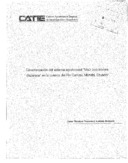| dc.description.abstract | El objeto del estudio fue caracterizar el sistema agroforestal de maíz con árboles dispersos en la Cuenca del Río Carrizal, Manabí, Ecuador. En 54 fincas, se caracterizó la riqueza, abundancia, diversidad y composición de los árboles dispersos en parcelas de maíz. Además se describió el manejo y uso de los árboles dispersos y se evaluó las percepciones de los productores hacia el sistema agroforestal, mediante encuestas individuales semiestructuradas que incluían aspectos sociales, agrícolas y forestales. Para ver si había diferencias entre los tipos de productores y sus sistemas agroforestal, se realizó una tipología de productores mediante el análisis de variancia mínima de Ward y prueba de pseudo "T" y se comparó la cobertura arbórea presente y su manejo entre los diferentes grupos. El sistema agroforestal de maíz con árboles dispersos forma parte importante del ciclo productivo. Las fincas tenían en promedio 12,5 ha con una diversidad de usos del suelo, donde el maíz ocupaba el 50 por ciento de la superficie de la finca con 5,9 ha en promedio. el ciclo de Producción del maíz se realizó en ocho años: seis años de maíz y posteriormente dos años de descanso en charral donde se produce el establecimiento de las especies arbóreas vía regeneración natural. En cada ciclo de cosecha de maíz, el ganado entra en la parcela, consumiendo el rastrojo y ramoneando hojas y frutos de los árboles. The objective of the study was to characterize the dispersed trees in corn fields in the Rio Carrizal basin, Manabí, Ecuador. The richness, abundance, diversity and composition of dispersed trees in corn fields were characterized in 54 farMON. The management and use of the trees were described and the perceptions of the farmers towards the agroforestry system were evaluated through semi-structured interviews that included social, agricultural and forestry aspects. In order to see if there were differences among the types of farmers and their agroforestry systeMON, a typology of the farmers was produced using Ward's minimal variance analysis and a pseudo T test, and the tree component and its management were compared among the different groups of farmers. The agroforestry system of dispersed trees in corn fields is an important part of the productive cycle. The average area of the farMON was 12.5 ha, with corn representing 50 percent of farm's area (mean area of 5.9 ha per farm). The corn productive cycle consists of 8 years: 6 years of corn production and 2 years of rest in charral, during which time the trees establish through natural regeneration. At the end of the annual productive cycle, the livestock enter the fields, feeding on corn stubble and browsing leaves and fruits from the trees. | es_ES |


